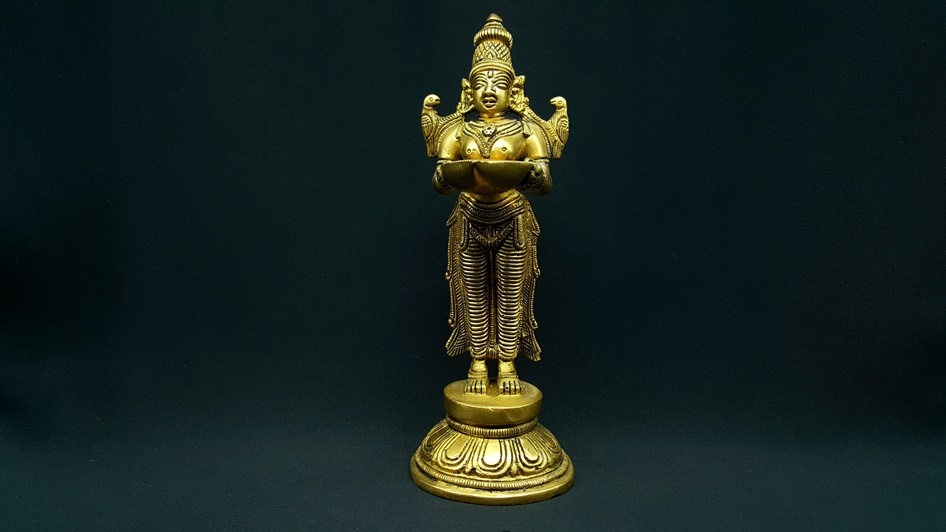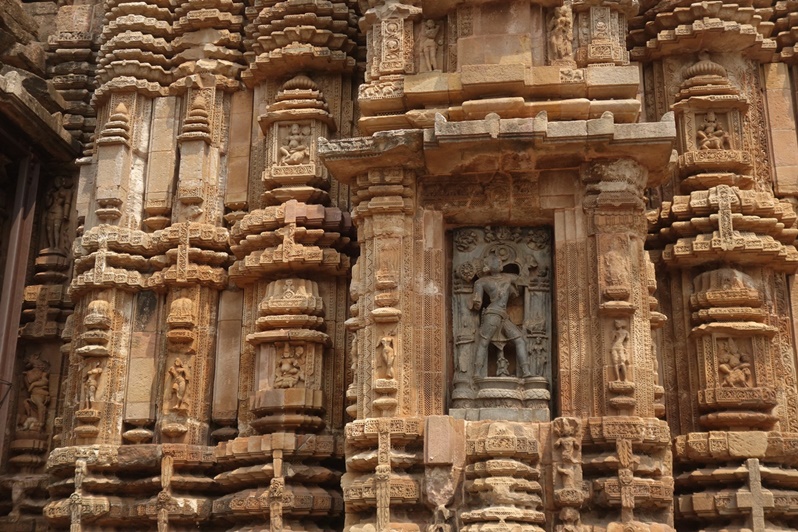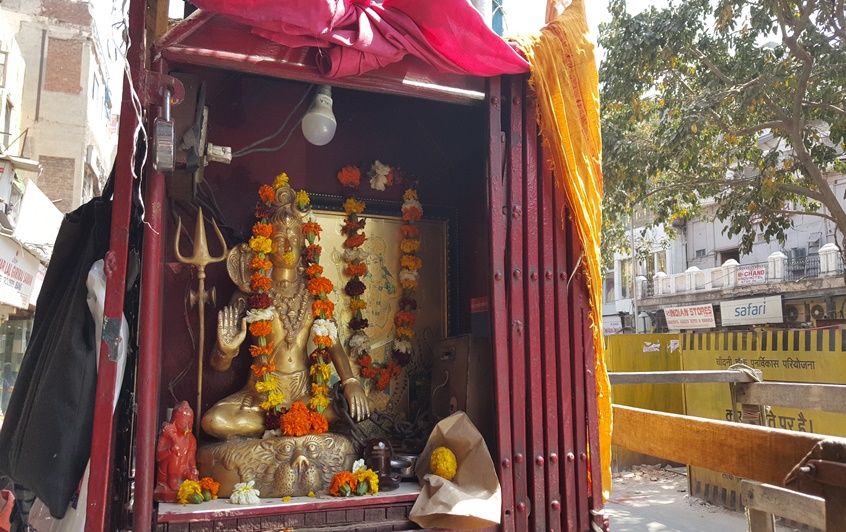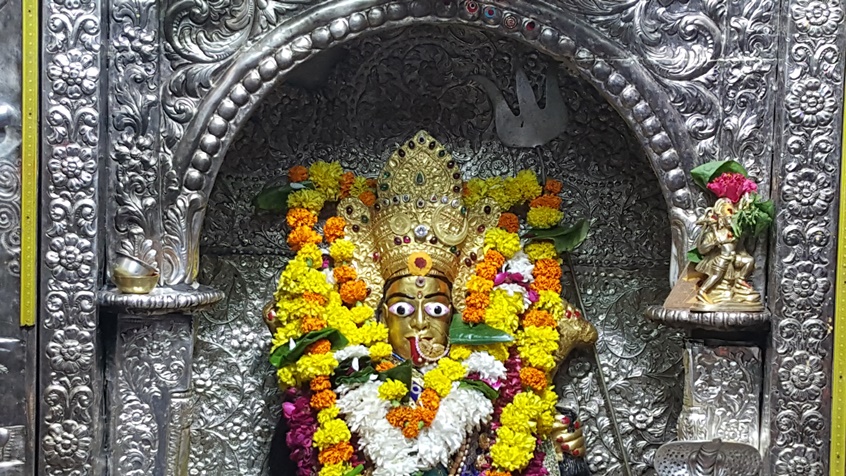
par Bertrand Bellaize, le 14 septembre 2020
Hindouisme - divinité hindoue : la Trimurti – Lakshmi
La Trimurti est le socle de l’enseignement spirituel hindou qui permet d’expliciter le monde manifesté dans laquelle nous évoluons : Brahma représente le principe créateur, Vishnou, le préservateur et Shiva le destructeur qui permet le renouvellement. Ces trois forces sont indissociables, complémentaires et opposées.
Cependant le principe actif, soit la Shakti, l’énergie créatrice, est manifesté par le coté féminin de la divinité hindoue : pour Vishnou, il s’agit de Lakshmi, son épouse.
Elle naquit du barattage des eaux primordiales par les Dieux aidés de Vishnou et apparaît assise sur un lotus ou tenant un lotus à la main. Cependant d'après le Vishnu Purana, elle est la fille du sage Bhrigu et de son épouse Khyati. Mais elle peut être aussi la fille de Shiva et Parvati ! En fait, au fil de l’évolution de l’hindouisme, les qualités et l’importance des divinités évoluent, ce qui explique les origines diverses attribuées à Lakshmi.
Elle accompagne toujours Vishnou, en tant qu‘épouse, lors de chacune de ses incarnations en tant qu’avatar : elle est La dame au Lotus (Padma) lorsqu’il fût Vâmana, le nain, puis Sillon (Sita) qui jaillit du travail de la charrue dans le Ramayana. Elle est Radha et Rukhmini, les compagnes de Krishna dans la Bhagavad-Gita...
L’association de Vishnou et de Lakshmi est indispensable : aux cotés de Vishnou qui assure le maintien, l’équilibre du monde, qui lui donne les conditions d’un développement harmonieux, elle représente la fécondité, l’abondance, le bonheur qui s’épanouit lorsque toutes les conditions sont réunies. Ils forment le couple idéal garantissant l’équilibre, la stabilité et un espace fécond.
On les vénère , d’ailleurs, souvent ensemble sous le nom de Lakshminârâyan. Ils sont en fait inséparables, ne font qu’un et cela est symbolisé par la touffe de poil (Shri Vasta, voir article sur Vishnou) qui orne la poitrine de Vishnou et lui rappelle constamment Lakshmi.
Mâhâ Lakshmi, la fortune transcendante
Lakshmi, reine du monde, illumine l’univers et revêt les qualités de tous les Dieux : sa forme est alors composée de divers éléments provenant de tous les dieux : bras faits de la substance de Vishnou, sa taille, rouge provient d’Indra, ses pieds de Brahma…. Ses nombreux bras portent, dès lors, de multiples attributs aux fonctions variés. Elle est la personnification de l’Absolu.
La fonction primordiale de Lakshmi est sa qualité de fécondité : c’est elle qui permet à la manifestation d’émerger, d’être et de se déployer. Elle est donc la matrice sous-jacente, latente. Elle est le fondement, le socle de toutes choses, sans elle, rien ne peut se développer. En ce sens, elle peut personnifier la terre (Bhûdhevî, déesse de la terre est alors considérée comme un des fonctions de Lakshmi).
Elle incarne donc la fonction active de l’énergie tandis que Vishnou apporte la stabilité, l’équilibre. Pour que la vie se déploie, il faut un équilibre entre deux forces : maintien et expansion.
Au delà de cette fonction, Lakshmi incarne le pouvoir, la souveraineté, la capacité : ces qualités vont permettre au couple Vishnou-Lakshmi de faire régner le Dharma, l’ordre juste. Lakshmi est ainsi associée à la royauté, à ceux qui gouvernent, administrent, font les lois, assurent la justice, la sécurité….
Elle prend alors le nom de Devi, Déesse, Lokamâtâ, Mère du monde, Nârâyanî, Mère éternelle, Indirâ, puissante, Hira, joyau...
Lakshmi, déesse de la prospérité, de la beauté et de la fertilité
Une fois, le cadre de vie crée et fermement établi, Lakshmi est la divinité qui permet l’opulence.
La richesse qui coule de Lakshmi est avant tout spirituelle même si ses bienfaits concernent aussi l’existence matérielle. C’est une déesse nourricière, généreuse : elle protège, veille sur ses enfants. Elle répand ses bénédictions sur la terre.
Elle incarne donc la bonté, le don, le bonheur.
Par ailleurs, elle symbolise aussi l’épouse parfaite : elle représente la dévotion à l’époux, le service et le couple Vishnou-Lakshmi représente le couple idéal où règne l’harmonie et l’entente familiale.
On la nomme alors Shri, Splendeur, Beauté.
Les principaux attributs de Lakshmi
C’est une déesse qui ne porte pas d’armes, elle ne représente pas le coté combatif de l’énergie. Ces attributs et sa forme incarnent la sagesse, le don et les bénédictions.
La conque : le son grave éloigne les démons mais surtout symbolise l’infini et l’expansion (les anneaux partent d’un point pour s’élargir sans fin). Elle provient de l’eau, à l’origine de la création. Le son qu’elle produit est considéré comme le son primordial. La conque est reliée à l’élément eau.
Le serpent :
Le serpent est très important en Inde et bénéfique : il est le symbole de la fertilité, de vie (Shakti), du renouvellement permanent (mue) donc de l’immortalité.
Le vase d’abondance : Akshayaz Patra, le vase qui n’est jamais vide ou Purna Kumbha, le vase plein qui figurent l’abondance, la sagesse et l’immortalité.
Un fruit ou un épi : symbole nourricier, d’abondance.
Le lotus : Padma, un des noms de Lakshmi, symbolise la pureté, la beauté, la perfection. Il est le sein maternel, la matrice d'où viennent toutes choses. C'est le siège du principe féminin, la Shakti.
Le lotus donne une fleur de toute beauté, alors qu'il provient d'un environnement marécageux, obscur, repoussant : il représente donc la possibilité de transformation, d'élévation.
C'est ainsi le trône des dieux, la matrice dont ils sont issus. Il figure aussi le centre, le Guna Sattva. Ses pétales expriment le déploiement de l’univers.
Les formes de Lakshmi
Lakshmi est toujours représentée comme une glorieuse et très belle femme : elle est radieuse, son visage est empreint de bonté. Elle dégage une impression de pur bonheur, de joie qui remplit les coeurs.
Elle richement parée et assume un port royal rehaussé par de nombreux bijoux en or, la tiare qui la couronne et elle scintille des reflets des pierres précieuses : elle brille tel le feu ou le soleil. Et de ses mains, tournées vers le bas s’écoulent des flots de pièces d’or : elle fait don de la fortune !
Son sari est rouge, couleur de l’amour, de la victoire, de la sagesse divine, sa peau peut être sombre telle celle de son époux mais le plus souvent elle est rose (mélange du rouge et du blanc, la couleur de l’amour), blanche ou dorée.
Lakshmi est souvent représentée et honorée sous huit formes, les Ashtas Lakshmi qui déclinent la fortune sous différents aspects: Bhâgya-Lakshmi, la chance ; Gaja-Lakshmi, le pouvoir ; Dâna-Lakshmi, la richesse ; Dhânya-Lakshmi, la nourriture, dhanya signifiant les grains ; Santâna-Lakshmi, la descendance ; Vidyâ-Lakshmi, la connaissance ; Vîrâ-Lakshmi, la force et Vaibhava-Lakshmi, la réussite.
Elle est alors assise dans un lotus, est parée de deux à huit bras munis de différents attributs. Le temple de Ashtalakshmi à Hyderabad lui est consacré.
Gaja-Lakshmi, Lakshmi encadrée de deux éléphants
Lorsque Lakshmi émergea de l’océan de lait, elle est sacrée reine du monde par deux éléphants qui lui versent de l’eau sur elle : l’eau qui rappelle l’origine de toutes manifestations, l’eau qui permet la vie, la croissance, le développement. Les éléphants symbolisent la force, le pouvoir.
Lorsqu’elle est représentée aux cotés de Vishnou, Lakshmi n’a que deux bras. Elle est alors debout ou assise sur sa gauche (voire sur un de ses genoux) et peut tenir un lotus d’une main tandis que l’autre fait le geste de Varadra mudra soit le geste du don, de l’offrande.
Lakshmi est aussi figurée avec certains démons et rois en tant que partenaire : elle leur donne une légitimité de pouvoir, de royauté : son influence est alors bénéfique.
Son association avec d’autres dieux (tel Indra, Kubera…) renforcent toujours leurs qualités.
Sa monture est la chouette : cependant on la voit peu à ses cotés car cet oiseau, tout en symbolisant la sagesse et la capacité de voir dans les ténèbres, incarne aussi la malchance, voir la folie ! Elle est donc plutôt accompagnée de Garuda aux cotés de Vishnou.
Le culte de Lakshmi
Lakshmi a peu de temples qui lui sont dédiée en propre (cependant le nombre de temple qui lui est consacré s’accroît d’année en année) mais elle est vénérée dans de nombreux lieux saints aux cotés de Vishnou et surtout, à titre privé, à l’intérieur de nombreuses demeures : de part ses qualités, elle fait partie des divinités les plus populaires et est choisie par de nombreux fidèles (commerçants, agriculteurs, hommes d’affaires….) comme leur Ishta Devata. Les offrandes évoquent l’abondance, tout ce qui peut rappeler la beauté, la douceur dans cette existence.
Les cérémonies et rituels associent très souvent Vishnou et Lakshmi et les nombreuses péripéties liées à leur couple font même l’objet de jeux de scènes lors de Pranayakalacha (Fête des querelles amoureuses).
Une des particularités du culte de Lakshmi vient du fait qu’elle est aussi honorée par certains autres dieux tel Ganesh.
A noter : Lakshmi est la seule déesse qui possède sa divinité opposée Alakshmi, l’Infortune (parfois symbolisée par la chouette) !
Sources
Sarah Combe - Un et Multiple – Editions Dervy
Alain Daniélou : Mythes et Dieux de l’Inde


